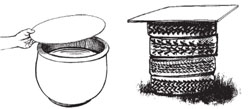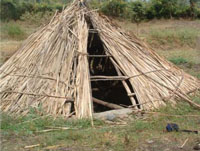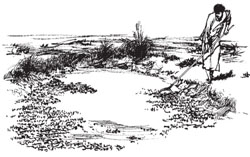9.2.3 Environmental manipulation
Increasing the flow of streams, regulation of the water level in reservoirs, vegetation removal and shading are examples of environmental manipulation activities. The following are some of the environmental manipulation activities which are useful for mosquito control:

Closing, screening or covering breeding sites
Potential breeding sites in relatively small enclosed habitats, such as drinking water storage containers, tyres and wells, should be made inaccessible to adult mosquitoes by covering them (e.g. as in Figure 9.4). Removable covers, such as mosquito-proof lids or wire mesh screening, can be fitted in some cases. Wells can be made mosquito-proof by closing them with slabs, an iron sheet or grass, and installing hand pumps.
Flushing
Flushing (increasing water flow in streams) is employed in small streams where there is a continuous and abundant supply of water flowing slowly enough to permit mosquitoes to breed in quiet places along the margins. A periodic discharge of a large volume of water washes away the eggs, larvae and pupae from the edges, or strands them on the banks.
In order to collect the water needed for flushing, a small dam is constructed upstream of the area where breeding occurs. The dam site should be at a point where the stream or channel is narrow and the banks are high. The dam could have a hand-operated gate, to release the water at least once a week. The method requires some initial investment, but is long-lasting and requires little maintenance. Health Extension Practitioners can mobilise the community to construct a small dam and water release system wherever such a measure is feasible to control mosquito breeding in the village.
Shading of ponds and stream banks
Where mosquitoes prefer breeding sites that are partly or fully exposed to sunlight, they can be controlled by planting shrubs and trees along the banks of streams and covering ponds with iron sheets or local materials (Figure 9.5). The main vector of malaria in Ethiopia, An. arabiensis, prefers to breed in sunlit water, so this intervention could be helpful.

Removal of water plants

Mosquitoes can be controlled by removing vegetation from water collections. The plants provide the developing larvae with a safe hiding place from predators (e.g. fish), as well as protection from wave movement and currents. In small breeding sites, such as borrow-pits and ponds, the vegetation can be removed manually, for example by the members of communities, using rakes and other simple equipment (Figure 9.6). This method may also be effective in removing resting places for adult mosquitoes. In addition, it promotes evaporation and the drying up of small accumulations of water and makes breeding sites more visible for control purposes.
Straightening and steepening shorelines
Shorelines of streams, ditches and ponds can be made steeper to reduce the availability of shallow places suitable for breeding of mosquitoes, and to increase the speed of the flowing water.
9.2.2 Environmental modification
